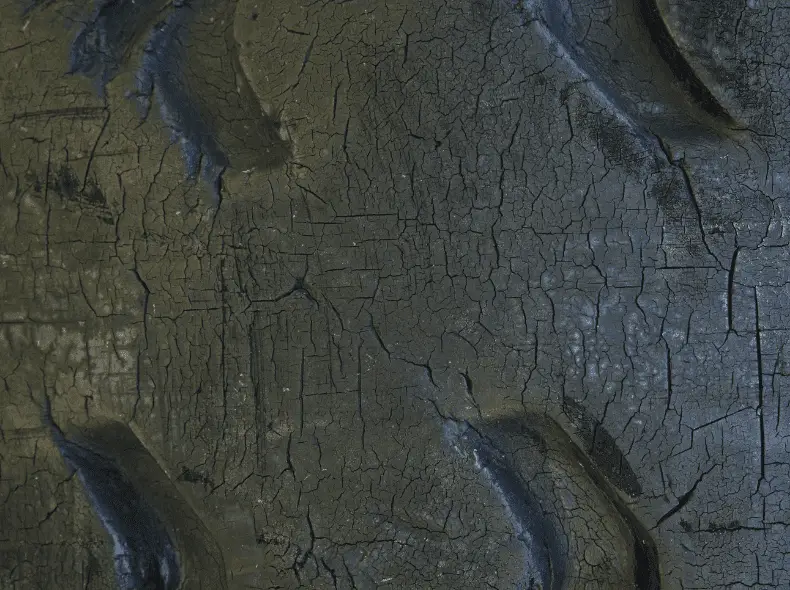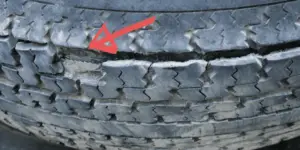People often ask this question when they take off their summer or winter tires and store them in a garage.
There are definitely things you can do to prolong the life of your tires and prevent dry rot from setting in too quickly.
It normally takes 5 to 7 years for dry rot to become apparent on tires. If you take sensible and logical steps to protect them, the tread will likely wear far quicker than dry rot becomes established, solving the problem.
You might have taken your tires off yourself or been to a tire shop, and they’ve done it for you. The best place to store your tires would be in a garage but is far more to it than that.
How To Prevent Dry Rot and Prolong The Life Of Tires In Storage
If you follow the steps below, your tires are far less likely to quickly be affected by dry rot.
Clean Your Tires
Without you knowing, your tires are picking up chemicals from the road as you drive, which can cause the early onset of dry rot.
All the chemicals react differently, and some chemicals deposited on the road will badly affect the flexibility of your tires.
Road salt, especially in the salt states, harms rubber tires.
Always clean them off well on the tread and sidewall before storing them.
You’ll likely store your tires for a minimum of 5 months, and having salt or other chemicals on your tires over this period can cause dry rot quicker.
UV Sunlight
UV sun rays are bad for tires as they dry them out quickly. Even in a garage situation, your tires will still be affected if you have a window that lets natural light in.
The sunlight dries out the chemicals used in manufacturing your tires to keep the rubber supple. When this is diminished, the tires will start to crack.
You can cover any windows in the garage so sunlight cannot get in or cover the wheels and tires, so they are not affected.
Both options will extend the time that tires become affected by dry rot.
If you don’t want to go to the trouble of doing this, you can buy a UV tire protector that you can spray on your tires, protecting them from UV light to at least some degree.
Humidity and Temperature
Rubber does expand and contract in relation to temperature. Garages can get very hot and very cold as there is little insulation.
This can cause the rubber to crack sooner, but keeping the air temperature around 60 degrees Fahrenheit will help. Tires will also start dry rotting sooner if the air is too dry.
A good rule of thumb is 40 to 50% humidity. Higher humidity causes the inside of your garage and tires to become moist over an extended period. This also increases the chances of flat spotting them.
Remove The Tires From The Car To Prevent Dry Rotting
You may have done this already, especially if you are changing your tires for the new season.
While others are storing a car and not just the tires, if this is you, it would certainly pay dividends to jack up your car and remove the wheels and tires from it.
When your tires are stationary, certain areas will be under more stress for longer than if you were driving and only parked overnight. Flat spotting could be the issue, but dry rot can also take effect.
The areas where you are likely to see dry rot would be on the area against the garage floor, as this, even in properly inflated tires, are under more stress than the area above.

If you want to avoid taking off your tires from your car, it would be a good idea to occasionally drive your car short distances before parking it in storage again.
This way, you take the stress off that tire area and are likely to park on a different tire area when returning to store it again.
To ensure you do this, you could always use chalk to mark the tire area that was in contact with the garage floor, so you know a different area is in contact when you return to park.
Store In Air Tight Bags
A cheap way to ensure your tires are not affected by sunlight or any chemical spills in your garage or do not suffer from flat spotting and dry rotting is to put them in plastic bags.
Large yard bags or leaf bags are a cheap way to protect your tires while off a car. It’s always best to try and remove as much air as possible to store them. Ozone plays a part in dry rotting tires and is a naturally occurring gas.
Less air in the bag will mean less chance of them dry rotting and make them last longer.
Early Signs Of Dry Rot on Tires
Tire Color Changes To Gray
A very early indicator that your tire is likely to become dry-rotted is the color of the tire. When your tire leaves the factory, it is a lovely dark black color.
The sun’s UV rays dry out car tires and cause cracking; they can also change the darkness of the tire. If the tire is less dark and even becomes slightly grey, this is an early indication that the rubber is starting to fail.
Tire Losing Air Pressure
Dried rotted tires will allow oxygen and nitrogen molecules to leave via the cracks. This may be very subtle, and you may not notice.
If you suspect that one tire is dry rotted, it is worth paying attention to see if this tire loses more air than the other ones that you do not suspect.
The cracks are often invisible to the human eye but big enough to let air through.
Dry Rot or Weathered Tires
Dry and weathered tires are the same. Weathering is the cause of dry rotting. The sun dries out the tires, as does salt on the roads. If you think your tires are weathered, this is the early stages of dry rot.

Can Tires Dry Out Prematurely?
It is extremely unusual for tires to become dry rotted within three years.
It is difficult to see how long expensive branded tires made in the US outperform cheaper imported tires concerning dry rot.
We can make assumptions in relation to research and development, though.
Tire brands like Continental and Michelin spend hundreds of millions of dollars on research and development each year compared to the cheaper Chinese imported tires.
The logical conclusion is that some of the research in the budget goes into tire longevity, chemicals used in the manufacturing process, and the life expectancy of tires.
Once tires show signs of dry rot, they should be changed immediately. Many people ask if they can continue driving until it gets worse; unless the damage is purely cosmetic and superficial, the answer is no.
What Causes Dry Rot on Tires To Happen Faster?
- Prolonged exposure to sun UV rays
- Salt on roads and chemicals not being washed off regularly
- Extremes in humidity
- Lack of driving
- Poor storage
In Conclusion
Tires will normally start getting dry rot after 5 to 7 years. This can happen quicker when they are exposed to lots of UV sun rays and chemicals on the road.
Always wash your tires regularly to stop chemical buildup, and use a UV protector on your tires to reduce the damage UV rays do. These two basic steps will help your tires last longer from dry rot.
Sources
https://www.continental-tires.com/car/tire-knowledge/tire-care-maintenance/storing-tires



![Minor Dry Rotted Tires [GUIDE] Tire-veins-dry-rot](https://carzaza.com/wp-content/uploads/2023/12/Tire-veins-dry-rot-300x150.png)

![How Long Do New Tires Take To Put On? [ANSWERED] Torque-wrench-tire](https://carzaza.com/wp-content/uploads/2023/12/Torque-wrench-tire-300x150.png)
![Can Tires Be Put On Backwards -[Answered Fully] directionl-tire-noise](https://carzaza.com/wp-content/uploads/2023/12/directionl-tire-noise-300x150.png)






